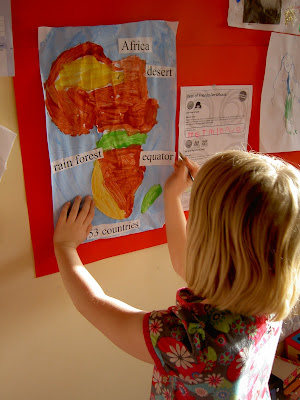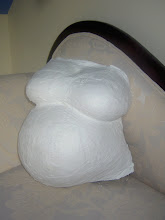I've finally got round to blogging our first couple of sessions having put off and put off waiting for Blogger to sort itself out - which incidentally still hasn't happened.
First session - Introduction
In our first session we located Africa on our big map of the world. I explained that it is a continent made up of 53 countries. Surprisingly Hermione already knew it was a continent – I had thought this would be the first time she had come across this concept. It amazes me how much my kids just soak up in the way of knowledge from day to day life – learning all the time as John Holt might say.
Africa makes up one fifth of our land mass. This prompted a bit of fraction play which Miles was also very enthusiastic about.
In our first session we located Africa on our big map of the world. I explained that it is a continent made up of 53 countries. Surprisingly Hermione already knew it was a continent – I had thought this would be the first time she had come across this concept. It amazes me how much my kids just soak up in the way of knowledge from day to day life – learning all the time as John Holt might say.
Africa makes up one fifth of our land mass. This prompted a bit of fraction play which Miles was also very enthusiastic about.

Because Africa is so big and covers such a huge area it has different climates. We made our own map of Africa and roughly identified a couple of areas of desert and rainforest.
Next came talk of the equator. We found it on our world map and drew it on our own map.

Second session - Deserts
We talked about some of the large desert areas in Africa and identified them on the map.
We asked ‘what is a desert’? Discussions about areas with very low rainfall and sparse vegetation followed. We measured ten inches on the tape measure and thought of how odd it would be if it only ever rained every couple of years.
We talked about oases and looked at some pictures. I realised as we were doing this that most notable oases are not actually in Africa. Never mind, I still felt justified in including them.
We carried out an experiment about aquifers, with limited success. We built up layers of rock, sand, clay and gravel in the largest glass container I had (a not so large vase). We then poured water carefully over the top and noticed how it collected in some areas – noticeably just above the clay layers.

Once we had seen how water can become trapped in layers of the earth we mixed a very small amount of water with red food colouring and poured it on the top. It took a little while but in the end it permeated down and coloured the water trapped below – showing how aquifers are prone to pollution.

The aquifers weren’t clear in such a small container but I think this experiment could be really good in something like an old fish tank.
What grows in the dessert? There are some plants and many have a couple of noticeable characteristics - broad shallow root systems so that they can access as much water as quickly as possible when it does rain, and/or, succulent leaves.
What grows in the dessert? There are some plants and many have a couple of noticeable characteristics - broad shallow root systems so that they can access as much water as quickly as possible when it does rain, and/or, succulent leaves.
We looked at the succulents in the glass house on our next visit to the Botanic Gardens.


I decided this was a good point to mention plant classification again so I made a couple of sets of cards and we sorted them into evergreens and succulents – not particularly challenging I know but my main priority was just to reinforce the idea of most things in nature belonging to some sort of family classification.

Goodness, is the grout in my hall really that dirty?
We read a traditional African folk tale called Two Ways to Count to Ten which I found here.
That’s all I have time for. It's taken so long to write this post with all the current Blogger issues and it still isn't right - spacing and general formatting are up the creek. Still to come are rainforests, social issues and our African evening.
That’s all I have time for. It's taken so long to write this post with all the current Blogger issues and it still isn't right - spacing and general formatting are up the creek. Still to come are rainforests, social issues and our African evening.


4 comments:
Wow Claire that's really impressive!
Have to admit that first time I saw the aquifer I thought it was some sort of sickly dessert though. (angel delight, jelly beans and dream topping). Much better experiment than dessert, lol!
Lxx
Brilliant. Not sure what is going on with blogger for you but I haven't had any problems with it. Very odd isn' t it?
I thought the same as Linda too, I thought it was a dessert. Infact I actually misread the title post as Africa-intro and 'dessert' so it seemed natural to have a dessert in there *blushes*
It's really good what you have done, I've picked up some pointers and tips that I think I can use at home :-)
Regarding your blogger problems,
I have a practise blog, that I use to try out different things, perhaps ceate a new blog to mess about with, if you don't already have another blog and see if the same problems happen there. Otherwise perhaps contact blogger to see if they can help.
CJ x
Thank you for the Blogger pointers and compliments on our Africa stuff.
The aquifer does look like a dessert - not helped by the use of multicoloured gravel! Would have been great in a big tank - honestly :-)
Post a Comment